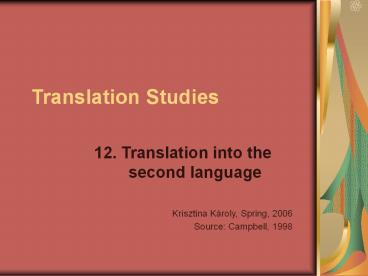Translation Studies - PowerPoint PPT Presentation
Title:
Translation Studies
Description:
Translation Studies 12. Translation into the second language Krisztina K roly, Spring, 2006 Source: Campbell, 1998 Aim of book: to explore how individuals develop ... – PowerPoint PPT presentation
Number of Views:193
Avg rating:3.0/5.0
Title: Translation Studies
1
Translation Studies
- 12. Translation into the second language
- Krisztina Károly, Spring, 2006
- Source Campbell, 1998
2
Aim of book
- to explore how individuals develop the
competence to translate into a second language,
and to show that a key aspect textual
competence is developed in a systematic way.
(p.2) - Importance of a translator-centered view on
translation (focus on process the translator in
context)
3
Problems in translation to L2 are related to
- second language acquisition (acquisition of L2
skills and strategies, L development) - interlanguage (output a stage in L acquisition)
- organization of L above the sentence level (DA
production of stylistically authentic texts
textual skills in L2) - levels of L competence (translation standards)
4
Recent studies on translation competence (TC)
- Toury (1984) bilinguals have an innate
translation competence comprising bilingual and
interlingual ability as well as transfer
competence (pp.189-190) - Bell (1991) ideal bilingual competence
expert system communicative competence
(Canale and Swain, 1980 grammatical,
sociolinguistic, discourse, strategic) - Kiraly (1990) stresses the importance of the
process of second language acquisition in
teaching translation into FLs
5
Recent studies cont.
- Hewson and Martin (1991) acquired
interlinguistic competence (comp. in 2 Ls and 2
cultures) dissimilative competence
transferred competence (translation
auxiliaries) - Nord (1992) competence of text reception and
analysis, research competence, transfer
competence, competence of text production,
competence of translation quality assessment,
linguistic and cultural competence (both on the
source and target side) ? text-analytical
perspective - Pym (1992) ability to generate a target-text
series select only one target text from this
series as a replacement of source text for a
specific purpose and reader ? behavioral
perspective
6
Possible approaches to conceptualizing TC
(depending on purpose)
- psychological modeling of the T process
(inferring mental constructs from empirical data
TAP at different levels of translator ability
or longitudinally in student translators) ? focus
on translator, text, readers - translation quality assessment (the quality of
the translated text is a reflection of the
translators competence) ? focus on text, readers
and the relationship of the two - translation pedagogy (importance of
discourse/translation analysis, intertextuality,
interference, lack of student-centered view) ?
focus on theories of teaching and learning
7
Translation into the second language (vs. first
language)
- TC in an interlanguage framework (following
Selinker, 1992 and Larsen-Freeman and Long, 1991) - contrastive analysis
- error analysis
- performance analysis
- discourse analysis
8
Purpose of a pedagogical model of TC
- identify underlying components of TC to aid
curricula - describe developmental pathway taken in learning
how to translate to aid sequencing of curricula - include means for describing quality differences
between translations to aid the development of
assessment techniques
9
Towards a model of translation competence (into
L2) ? based on empirical research
- 3 components in Campbells (1998) model
10
3 components in Campbells (1998) model cont.
- (1) TL textual competence (the ability to
manipulate the genre potential of the TL, by
deploying grammar and lexis above the sentence
level) - - substrandard
- - pretextual
- - textual
11
3 components in Campbells (1998) model cont.
- (2) Disposition (individual characteristics of
the translator, unrelated to L competence) - - risk-taking vs. prudent
- - persistent vs. capitulating
12
3 components in Campbells (1998) model cont.
- (3) Monitoring competence
- - low awareness of quality of output ?
ineffective editing strategies - - high awareness of quality of output ? effective
editing strategies
13
Characteristics of the model
- shows that TC is divisible into components
shows the relative independence of the components - developmental dimension (in learning how to
translate) only the textual competence component
can be considered developmentally! - describes differences between translators ? can
be used in assessment of translation/translator
quality































